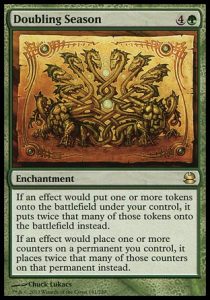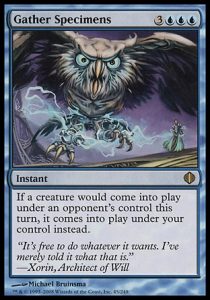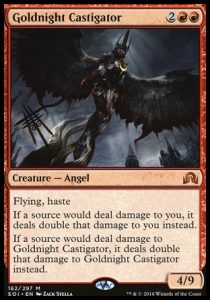Replacement Effects
What is a Replacement Effect?
Replacement effects are continuous effects that replace or modify one event with another.
Identifying Replacement Effects Lightning Round: What are the ways you can identify when something is a replacement effect?
 Aven Mindcensor
Aven Mindcensor
- Yes, this is the classic method of identifying a replacement effect as outlined in CR 614.1a – anything that uses the word “Instead” is a replacement effect.
- Eon Hub
- Yes, CR 614.b discusses how the word “Skip” indicates a replacement effect to indicate what events, steps, phases, or turns will be replaced with nothing.
- Hangarback Walker
- Yes, CR 614.1c discusses how “Enters the battlefield with” something is a replacement effect
- Stomping Ground
- Yes, CR 614.1c elaborates not only on Enters the battlefield with, but also “As [this permanent] enters the battlefield” and “[This permanent] enters the battlefield AS” like you’d find on a Clone.
- Alexander Smith
brought up the interaction between Stomping Ground and Vesuva, which led to Scott Markwart
posing the question “If you choose to have Vesuva enter the battlefield as a copy of Stomping Ground, what happens, and what options do you have?”
- In this instance, you have the option to pay 2 life to have the Stomping Ground enter untapped – but even if you do, it will enter tapped because it has 2 effects trying to have the object enter tapped. The Stomping Ground replacement effect gives you the option to pay life to have it enter untapped, but it will still be affected by the Vesuva ability forcing it to enter tapped, whether you paid life or not.
- Crypt Sliver
- This was a little trickier. Crypt Sliver grants an ability, which isn’t in itself a replacement effect. The ability it grants is an activated ability, which also isn’t a replacement effect. However the ability it gains as part of activating that ability, Regeneration, IS a replacement effect. You won’t find that info on the card though – CR 701.13a explains how regeneration uses a replacement effect to work.
- Felidar Sovereign
- No, this is no replacement effect on this card. The win the game ability is an “intervening if” triggered ability, and as was brought up in the discussion, Lifelink does not act as a replacement effect, but instead alters what the result of damage being dealt is (Read up on CR 702.15b for that one!)
- Jace, the Mind Sculptor
- Yes, the loyalty counters box on the bottom right of every planeswalker card is a replacement effect that modifies how the permanent enters the battlefield – with X loyalty counters on it. CR 614.1d also applies to Planeswalkers, as well as things that are planeswalker friendly like Doubling Season and similar effects like Hardened Scales.
- Hooded Hydra
- Yes, two in fact! Scott Markwart pointed out the two replacement effects: One we mentioned earlier replacing how it enters the battlefield with counters, along with the new and last replacement effect on the list – “As [this permanent] is turned face up” under CR 614.1e.
Replacement effects have certain timing restrictions on how they can apply. For example, can I cast Gather Specimens at the end of my opponents turn to take control of all the creatures she put into play during her turn?
 Holly Barra
Holly Barrajumped in on this one and correctly identified that Replacement Effects have to exist before the event would occur in order to replace it. You always apply replacement effects before an event would actually occur, and instead apply the new event. So in this instance, the effect from Gather Specimens would have to be in place before creatures enter the battlefield.
- This is also why you have to have a regeneration shield on a creature before it gets destroyed by a Doom Blade.
Next up – let’s talk about the duration of Replacement effects. If I cast Desperate Gambit on a creature Dragon-Style Twins with Double Strike, how much damage will be dealt if I win the flip and if I lose?
- Replacement effects last until they’re used up (only once) or until their duration expires.
- Clint Herron
and Josh Ohlendorf
got this particularly tricky exactly right – if you were to win the flip, Dragon-Style Twins would deal 12 damage, and if you lose, it would deal 4. Walking through the steps – Desperate Gambit would trigger prowess, and if you win, it would double the first strike damage from 4 to 8, and then deal 4 as part of the regular combat damage step. If you were to lose, the first strike damage would be prevented, but the regular combat damage would be applied, in which case they would take 4.
- In both scenarios, the replacement effect of “the next time a source would deal damage” was used up in the first strike damage step, and wouldn’t apply to the regular combat damage.
- Other examples of durations ending include things like Hallowed Moonlight, which would exile the creatures only until the end of the turn, not once it first applies. So even if I Fork a Collected Company, any creatures that enter off the first Collected Company will be exiled, along with any creatures that enter upon resolution of the second one.
Within replacement effects, there exists Self-Replacement effects. What replacement effects occur when I cast a kicked Burst Lightning on a player, and choose to redirect the damage to that player’s Jace?
- First off exists the Self-replacement Effect on Burst Lightning, which replaces the spell resolving to deal 2 damage to a creature or player with dealing 4 instead.
- Self-replacement Effects have to exist on the card itself and replace something about how it resolves. Kicker ends up replacing the amount of damage it would normally do with a different amount,
- Then the Planeswalker Redirection Rule applies, found in CR 306.7 – if noncombat damage would be dealt to a player by a source controlled by an opponent, that opponent may have that source deal that damage to a planeswalker the player controls instead. Importantly, this is not an effect that the player controlling the Planeswalker can use – you can’t force Jace to be your personal meat shield. This is an example of a redirection effect outlined in CR 614.9.
Now onto the fun stuff. What happens if we have multiple replacement effects trying to apply to the same thing? Let’s say in an EDH game we have Player A who casts their commander, while Player B and Player C both respond to the spell by casting and resolving Gather Specimens. Who gets Player A’s Commander??
- When multiple replacement effects would apply to the same object or player, the controller of the affected object will choose the order in which to apply them. And as each replacement effect would be used up once it’s applied, then you can determine the player who gets the creature from there.
- In this instance, Scott Markwart and Clint Herron worked together to get the correct answer. Scott identified that Player A is the controller of the affected object, and therefore chooses which replacement effect to apply – Player B’s, or Player C’s. Clint then pointed out that if Player B gets the creature based on Player A’s decision, then Player B still would have to apply the replacement effect from Player C’s Gather Specimens, as it only says if a creature would enter under an opponent’s control. So then Player C would have themselves Player A’s commander!
- See the facebook feed for the bonus question – what happens if Player A also cast and resolved Gather Specimens in the same turn? 🙂
And on to the Final Exam – let’s put this all into a real world scenario!
 Let’s say you control a Chandra, Torch of Defiance on 6 loyalty, and a Goldnight Castigator. I cast a kicked Burst Lightning, targeting you, and electing to defer the damage to Chandra. Identify and apply all replacement effects, and tell me: how much damage does Chandra take, and why?
Let’s say you control a Chandra, Torch of Defiance on 6 loyalty, and a Goldnight Castigator. I cast a kicked Burst Lightning, targeting you, and electing to defer the damage to Chandra. Identify and apply all replacement effects, and tell me: how much damage does Chandra take, and why?
- In this example we first apply self-replacement effects, so Burst Lightning will resolve dealing 4 damage. Then controller of the affected player/object chooses to apply Goldnight Castigator’s replacement effect, or the Redirection replacement effect first. Depending on the order they choose will determine how much damage is dealt to Chandra. Castigator says damage that would be dealt to YOU is doubled, so if you apply redirection first, it won’t be able to apply anymore, meaning chanda survives. But if you double the damage first with Goldnight Castigator, and then redirect, kiss your Chandra goodbye!
Further reading:
-Replacement effects: CR 614
-Interaction of Replacement and/or Prevention Effects: CR 616
Related articles:
–Replacement Effects
